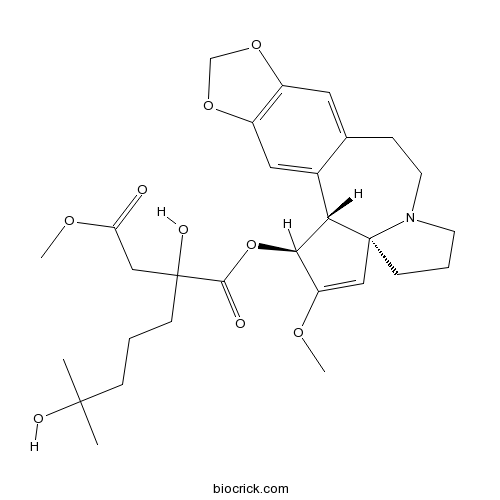Cephalotaxus mannii
Cephalotaxus mannii
1. The products in our compound library are selected from thousands of unique natural products; 2. It has the characteristics of diverse structure, diverse sources and wide coverage of activities; 3. Provide information on the activity of products from major journals, patents and research reports around the world, providing theoretical direction and research basis for further research and screening; 4. Free combination according to the type, source, target and disease of natural product; 5. The compound powder is placed in a covered tube and then discharged into a 10 x 10 cryostat; 6. Transport in ice pack or dry ice pack. Please store it at -20 °C as soon as possible after receiving the product, and use it as soon as possible after opening.
Natural products/compounds from Cephalotaxus mannii
- Cat.No. Product Name CAS Number COA
-
BCN4958
Homoharringtonine26833-87-4
Instructions

Mannolides A-C with an Intact Diterpenoid Skeleton Providing Insights on the Biosynthesis of Antitumor Cephalotaxus Troponoids.[Pubmed: 27042943]
Three new diterpenoids, mannolides A-C (1-3), and two new Cephalotaxus troponoids, 4 and 5, were isolated from Cephalotaxus mannii and structurally characterized by spectroscopic data and X-ray crystallography. The discovery of compounds 1-3 featuring a new intact carbon skeleton, proposed as cephalotane, sheds new light on the biogenesis of Cephalotaxus troponoids, a rare class of antitumor C19 norditerpenoids. Antitumor tests showed that the tropone motif is essential for the activity.
Effects and action mechanisms of sodium fluoride (NaF) on the growth and cephalotaxine production of Cephalotaxus mannii suspension cells.[Pubmed: 25442952]
To explore the effects of NaF on the growth and cephalotaxine production of Cephalotaxus mannii suspension cells, NaF was added into the C mannii cell suspension cultures at day 15 of culture time. It is documented that NaF suppressed cell growth but enhanced cephalotaxine production. The largest yield obtained of cephalotaxine reached to 9.57mg/L when the cultures were treated with an appropriate dosage of 15mg/L NaF, which was 3.7 times that of the control cultures (2.58mg/L). Additionally, NaF markedly enhanced the activity of glucose 6-phosphate dehydrogenase (G6PDH) and reduced the level of hydrogen peroxide (H2O2) of cells. It was also found that NaF weakened the oxidative damage of cell membrane and led to lower content of malonyl dialdehyde (MDA) in NaF-treated cells compared with the control cells. The MDA content of NaF-treated cells decreased 91% compared to the controls. Although lower membrane lipid peroxidation in NaF-treated cells, its membrane permeability was higher than the control cells and showed a high product secret rate. What is more, NaF boosted the activity of phenylalanine ammonium-lyse (PAL), but did not burst a peak of PAL activity in the time curve of PAL activity. These results indicated NaF acted as an inhibitor of the Enbden Parnas (EMP) pathway, not as an elicitor to promote cephalotaxine production.
Isotryptoquivaline F, a new quinazolinone derivative with anti TNF-α activity from Aspergillus sp. CM9a.[Pubmed: 25382555]
Isotryptoquivaline F (1) was isolated from Aspergillus sp. CM9a, an endophytic fungus of Cephalotaxus mannii. The structure was elucidated by extensively 1D and 2D NMR and HR ESI MS spectroscopy. It has good TNF-α antagonistic effect, and can be used for anti-inflammatory drugs or other bioactive leading drugs.
Aromatic compounds from endophytic fungus Colletotrichum sp. L10 of Cephalotaxus hainanensis Li.[Pubmed: 22417867]
Six aromatic compounds were isolated from the endophytic fungus Colletotrichum sp. of Cephalotaxus hainanensis Li [Cephalotaxus mannii Hook. f.]. Their structures were determined on the basis of chemical and spectroscopic methods. The compound 2 was the enantiomer of compound 1. The compound 4 was the epimeride of the compound 3. The compounds 1, 2, 4 and 5 were evaluated for cytostatic activity against HL-60 and PC-3 cells.


